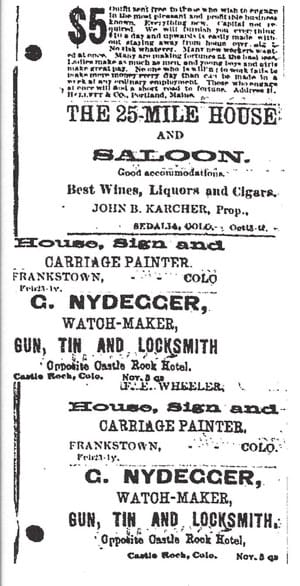John B. Karcher, French expat, firebrand and saloonkeeper

By Joe Gschwendtner; photo courtesy of the Castle Rock Journal

John B. Karcher of Sedalia was a Frenchman by birth. A large landholder in Alsace Lorraine, he was politically and socially active and a 32nd degree Mason. In his late 30s he was expelled from France because of his anti-Napoleonic tirades. His property was seized and within 24 hours he was banished forever.
Records indicate he took passage to New York City and while there, invested his remaining money wisely. A founder of the abolitionist Garibaldi Club, Karcher designed a parade banner that said, “No more slavery in 1861.”
Now labeled as an American firebrand, his actions triggered threatening, venomous letters, prompting an offer of police protection. In a subsequent New York City parade and protest, and despite a 28-man police security cohort, shots were fired, causing many serious injuries from the resulting melee.
Not long after, President Abraham Lincoln visited the city and was a guest of the Hotel Astor, where he was accosted by the Garibaldi Club. Lincoln asked who was responsible for the banner he had seen and Karcher owned up. Lincoln told him that the Constitution provided no authority for him to issue such an edict. Karcher’s reprimand notwithstanding, mere months later Lincoln issued the Emancipation Proclamation by executive order in September 1862.
Sustained restlessness brought Karcher west to the Wildcat Mountains. Sedalia caught his fancy. By 1881 he was the proprietor of the 25-Mile House and Saloon which offered “good accommodations, best wines, liquors and cigars.” Homestead Act records confirm he later paid cash for two quarter sections flanking the Riley (Daniels Park) Road in 1886 and 1887. On that land, 160 acres were inside today’s Castle Pines Village and included holes 4 through 6 of the Castle Pines Golf Club. Also included: most of the acreage south and west of Lost Trail, including the former location of the Devil’s Head Inn and the current Infinity Homes project.
In 1888, Karcher’s combative nature brought him into a district court squabble with the Douglas County road supervisor, Mr. Clay, who was forced to breach his wire fence impairing passage on Riley Road. The court eventually ruled against him determining that the county commissioners lawfully controlled free access on the old territorial road.
A man of varied interests, Karcher tired of the hospitality demands at his 25-Mile House, putting his Sedalia business up for sale. Via the Castle Rock Journal, he beseeched those who owed him money, also advertising that “the 25-Mile House at Sedalia will be sold CHEAP for cash” (pictured left). Burr Lewis and partner Frank Green bought the property in May 1889 and Karcher celebrated by taking his wife to Paris in June.
Out of the public eye, Karcher’s final decade was lived out on his ranch with access to Plum Creek’s muddy waters. His obituary appeared in March 1899, reporting that he was interred in the Fairmount Cemetery by the Masons of Schiller Lodge in Denver.
Wildcat Lore
As it turns out, The Connection serves residents of the Wildcat Mountains, a name pioneers and historians gave to the high country paralleling I-25 from Highlands Ranch and Lone Tree south to Castle Rock. Since the first territorial road (Daniels Park Road) bisected our mountains, there was no shortage of colorful characters parading through what are now private properties on the ridges of Douglas County. We bring these grizzled and gutsy settlers alive again, vividly sharing their stories of grit and achievement in these Castle Pines.